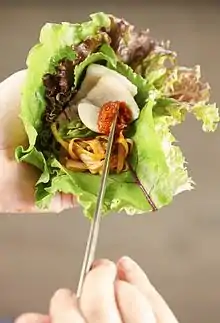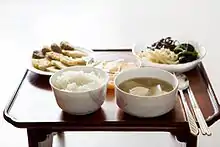Ssam
Ssam (쌈), sometimes also transliterated as ssäm, meaning "wrapped", refers to a dish in Korean cuisine in which, usually, leafy vegetables are used to wrap a piece of meat such as pork or other filling.[1] It is often accompanied by a condiment known as ssamjang and can also be topped with raw or cooked garlic, onion, green pepper, or a banchan (small side dish) such as kimchi.[2] Ssam is usually bite-sized to avoid spilling out the fillings.[3]
| Ssam | |
 lettuce leaf ssam | |
| Korean name | |
|---|---|
| Hangul | 쌈 |
| Revised Romanization | ssam |
| McCune–Reischauer | ssam |
 |
| This article is part of a series on |
| Korean cuisine 한국 요리 조선 료리 |
|---|
History
According to the book of customs, Dongguksesigi, ssam was eaten by the women of the Goryeo era who had been taken as maids or ladies of the court to Mongol's Yuan Dynasty, and by the end of the Joseon era, ssam had become an established seasonal dish. On the day of Daeboreum, the ssam that was eaten on that holiday was called bokssam (복쌈, good fortune ssam).[1]
Ssam is also slowly gaining popularity outside of Korea and is being served at restaurants in New York City, Tokyo and Brisbane.[4][5]
Variations
Various vegetables are used as ingredients such as lettuce, cabbage, bean leaves, and pumpkin leaves, which are used either raw or blanched. Seaweed such as miyeok (sea mustard seaweed) and gim (dried laver) are also used. Ssam can be used to refer to dishes using beef tongue, roe, pork, clams, or sea cucumbers wrapped and cooked in eggs.[1]
By ingredients
By wrap type
Specific types:[9]
- Baechu ssam (배추쌈), wrapped with napa cabbage leaf
- Chwi ssam (취쌈), wrapped with chwinamul
- Eossam (어쌈), wrapped with thin fish filet
- Gimssam (김쌈), wrapped with gim, seaweed[10]
- Gotgam ssam (곶감쌈), wrapped with dried persimmon
- Hobakip ssam (호박잎쌈), wrapped with pumpkin leaf[11]
- Jeonbok ssam (전복쌈), wrapped with sliced and soaked dried abalone
- Kimchi ssam (김치쌈), wrapped with kimchi
- Kkaenip ssam (깻잎쌈), wrapped with perilla leaf[12]
- Milssam (밀쌈), wrapped with a thin crepe made from wheat flour
- Muneo ssam (문어쌈), wrapped with sliced octopus
- Po'ssam (포쌈), wrapped with seasoned raw beef
- Sangchu ssam (상추쌈), wrapped with lettuce
Gallery
See also
References
- 쌈 (Ssam) Archived 2011-06-10 at the Wayback Machine Encyclopedia of Korean Culture (in Korean)
- "Customs". Korea Tourism Organization. Retrieved 2013-04-05.
- "How Make Ssam Bap (Korean Lettuce Wraps)". About.com.
- (in Korean) Restaurant opens in Sapporo, Financial News, 2006-06-16. Retrieved 2010-06-23
- Momofuku Ssam Archived 2010-06-27 at the Wayback Machine, Columbia Daily Tribune, 2010-06-23
- "Bossam's continuous popularity" Money & Business. 12 May 2010. Retrieved 2010-06-23 (in Korean)
- Jung, Alex "5 Korean ways to eat a pig" CNN Go. 11 November 2011. Retrieved 2012-04-11
- (in Korean) "Korean dictionary:Ssambap" National Institute of the Korean Language (in Korean)
- "쌈 (Ssam)" (in Korean). Doosan Encyclopedia.
- 김쌈 (in Korean). Naver Dictionary. Retrieved 2013-04-05.
- 호박잎쌈 (in Korean). Naver Dictionary. Retrieved 2013-04-05.
- 깻잎쌈 (in Korean). Naver Dictionary. Retrieved 2013-04-05.
External links
| Wikimedia Commons has media related to Ssam. |






